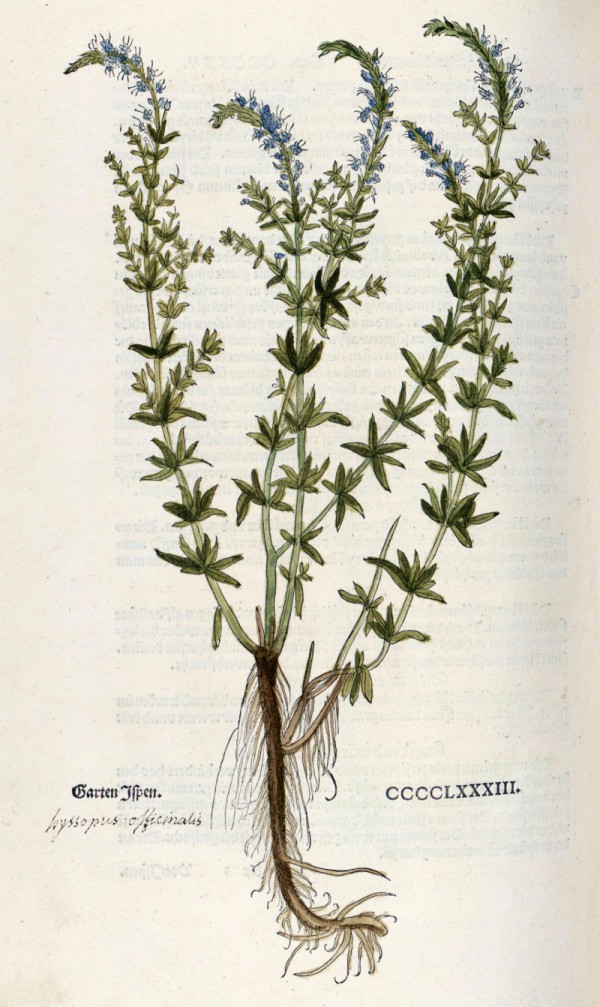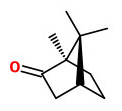Hyssopus officinalis L. - Lamiaceae - hyssop, Ysop
Perennial herb or subshrub, up to 60cm high, native to Southern Europe, Western Asia, naturalized in Northern America, cultivated; leaves linear to linear-oblong, entire, glabrous, gland-dotted below and above, sessile, upper leaves transitional into bracts; cymes 3-14-flowered; flowers violet-blue.
http://www.efloras.org/florataxon.aspx?flora_id=5&taxon_id=200019722
Some subordinate taxa are known like eg Hyssopus officinalis subsp. officinalis (Central Europe), Hyssopus officinalis var. decumbens (Jord. & Fourr.) Briq., Hyssopus officinalis subsp. canescens (DC.) Nyman.
http://www.tropicos.org/Name/17600092?tab=subordinatetaxa
„The essential oils from different parts of hyssop (Hyssopus officinalis L.) were investigated by means of GC and GC-MS at three stages of development of the plant. Besides the main components pinocamphone, camphor and β-pinene, 15 other terpenes were detected, among which were isopinocamphone, α and β-phellandrene, germacrene D, and some derivatives of myrtenol. The sesquiterpene alcohol hedycaryol was found to be converted to elemol during GC and MS analysis… Compared with the essential oil content (0.03-0.16% of the fresh plant material), the glycosidic bound volatiles were present in lower concentrations (0.01-0.06%). The glycosidic fraction was hydrolysed by means of Pectinol C and β-glucosidase yielding among others octan-3-ol, linalol, cis-nerolidol, benzyl alcohol, phenylethanol, eugenol and o-vanillin. The bicyclic terpenes myrtenol and verbenol could only be detected in small amounts as glycosides of the leaves. This fact gives reason for doubt about a direct connection between the glycosidic bound volatiles and the biogenesis of the essential oil components in hyssop.“
[Essential oils and glycosidic bound volatiles from leaves, stems, flowers and roots of Hyssopus officinalis L.(Lamiaceae)., Schulz, G., Stahl‐Biskup, E., Flavour and fragrance journal, 6(1), 1991, 69-73]
„Pinocamphone and isopinocamphone are present in H. officinalis (4.4% and 43.3%, respectively), according to the ISO 9841 Standard (1991 E) but they are lacking in var. decumbens, where linalool (51.7%), 1,8-cineole (12.3%) and limonene (5.1%) instead are predominant. The disc diffusion tests carried out on Gram-positive (Staphylococcus aureus and Enterococcus spp.) and Gram-negative bacteria (Klebsiella oxytoca, Escherichia coli, Proteus mirabilis, Pseudomonas spp. and two strains of Salmonella spp.) showed an antimicrobial activity generally negligible for H. officinalis, but broader, and in a few cases more evident (Enterococcus spp. and E. coli), for var. decumbens. All yeasts (seven strains of Candida albicans, C. krusei and C. tropicalis) were strongly inhibited by both species… Linalool, and in a lesser way, 1,8-cineole, may contribute to the greater antimicrobial activity of var. decumbens in comparison with H. officinalis, while limonene may be responsible for the antimycotic action observed in both oils, as suggested by results of the disc diffusion tests carried out on the pure reference substances.“
[Antimicrobial properties of the linalol‐rich essential oil of Hyssopus officinalis L. var decumbens (Lamiaceae)., Mazzanti, G., Battinelli, L., Salvatore, G., Flavour and Fragrance Journal, 13(5), 1998, 289-294]
„The essential oil and isopinocamphone inhibited the acetylcholine- and BaCl2-induced contractions in guinea-pig ileum in a concentration-dependent manner (IC50 42.4 microg/ml and 61.9 microg/ml to acetylcholine; 48.3 microg/ml and 70.4 microg/ml to BaCl2) whereas limonene or beta-pinene left tissue contraction unchanged. In guinea-pig ileum H. officinalis essential oil also blocked the contractions induced by CaCl2. In isolated rabbit jejunum the essential oil reduced the amplitude of spontaneous movements and decreased the basal tone; neither haemoglobin, methylene blue, N(omega)-nitro-L-arginine methyl ester (L-NAME) or propranolol blocked the myorelaxant effect.“
[Muscle relaxing activity of Hyssopus officinalis essential oil on isolated intestinal preparations., Lu, M., Battinelli, L., Daniele, C., Melchioni, C., Salvatore, G., Mazzanti, G., Planta medica, 68(3), 2002, 213-216]
Herb (Hyssopi herba) and essential oil (Hyssopi aetheroleum) are traditionally used to treat respiratory ailments (cough, bronchial inflammation and nasal congestion). „The oil is a gentle stimulant of circulation and also used in eyewashes and as a gargle… Expectorant properties are linked to marrubiin, while the antiseptic, spasmolytic and stimulant effects are ascribed to the essential oil. Pinocamphone and isopinocamphone are neurotoxic and thus similar to thujone. They are thought to inhibit cell respiration, resulting in spasms and epileptic fits at toxic doses. The essential oil should not be taken internally except in dilute form.“
[Medicinal Plants of the World. Ben-Erik Van Wyk and Michael Wink, Pretoria 2004, 177]
Aqueous methanol extracts of dried hyssop (Hyssopus officinalis) leaves showed α-glucosidase inhibitory activity. „Active principles against α-glucosidase, prepared from rat small intestine acetone powders, were isolated and characterized. The structures of these isolated compounds were determined to be (7S, 8S)-syringoylglycerol-9-O-(6′-O-cinnamoyl)-β-d-glucopyranoside and (7S, 8S)-syringoylglycerol 9-O-β-d-glucopyranoside…“
[Isolation of α-glusosidase inhibitors from hyssop (Hyssopus officinalis)., Matsuura, H., Miyazaki, H., Asakawa, C., Amano, M., Yoshihara, T., Mizutani, J., Phytochemistry, 65(1), 2004, 91-97]
Main components of Iranian supercritical fluid extracts were sabinene (4.2-17.1%), iso-pinocamphene (0.9-16.5%) and pinocamphene (0.7-13.6%).
[Supercriticial fluid extraction of flavors and fragrances from Hyssopus officinalis L. cultivated in Iran., Kazazi, H., Rezaei, K., Ghotb-Sharif, S.J., Emam-Djomeh, Z., Yamini, Y., Food Chemistry, 105(2), 2007, 805-811]

Fuchs,L., New Kreüterbuch, t.483 (1543)
http://plantgenera.org/species.php?id_species=548155
Hyssopus officinalis
© Rolf Marschner (2009),
www.botanische-spaziergaenge.at




